The portal visualised: from left to right the pathway of the energy from a resource to delivered power for ships.
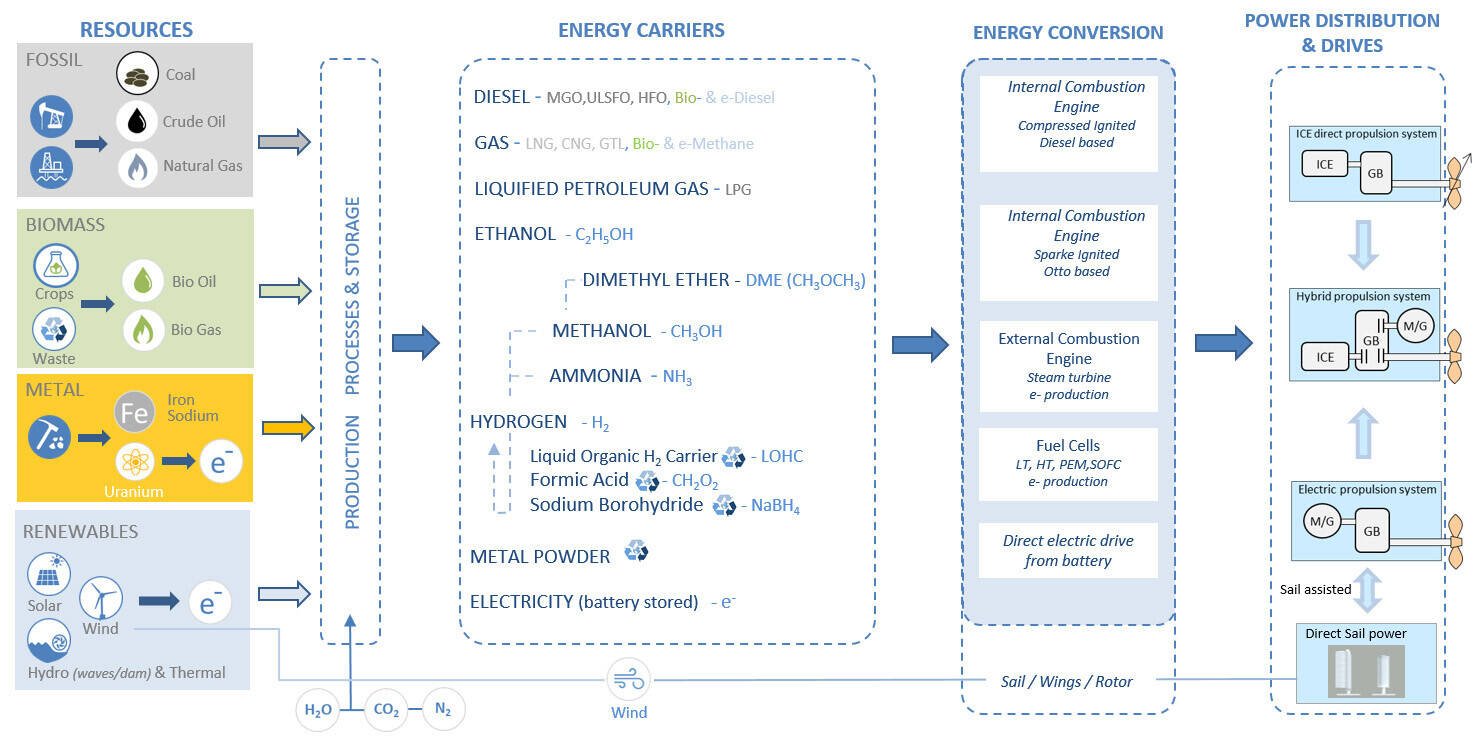
Each technology is set up in such a way that it always produces the same amount of power output.










October 2024, no. 141
More info
Interested? Contact us to discuss your options
Create a MARIN account to stay updated





Report
Sustainable Power Portal
MARIN continues to advance its Sustainable Power Portal. Originally developed in 2020, the online portal provides an independent overview of current and future energy carriers and power systems and their associated greenhouse gas emissions.
As part of MARIN’s strategy to contribute to the maritime energy transition, we invested in extending industry knowledge regarding energy carriers (hydrogen, methanol, biodiesels) and power systems (engines, fuel cells). However, it became clear pretty quickly that information about these systems is often difficult to find and compare, and the sources have varying accuracy.
Therefore, MARIN started collecting and evaluating information on this topic in 2018 via industry peers, conferences, scientific publications and suppliers, and decided to create a database so all the information was in one place, in 2020.
The energy and power systems that were part of the study.

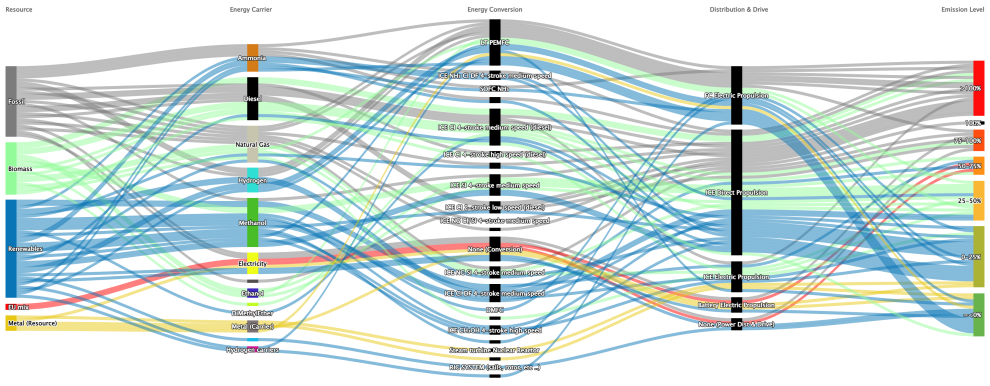
Overview of Energy-Power Systems pathways and the relative impact on emissions, as documented in the portal. Interactive overview is available at https://sustainablepower.application.marin.nl
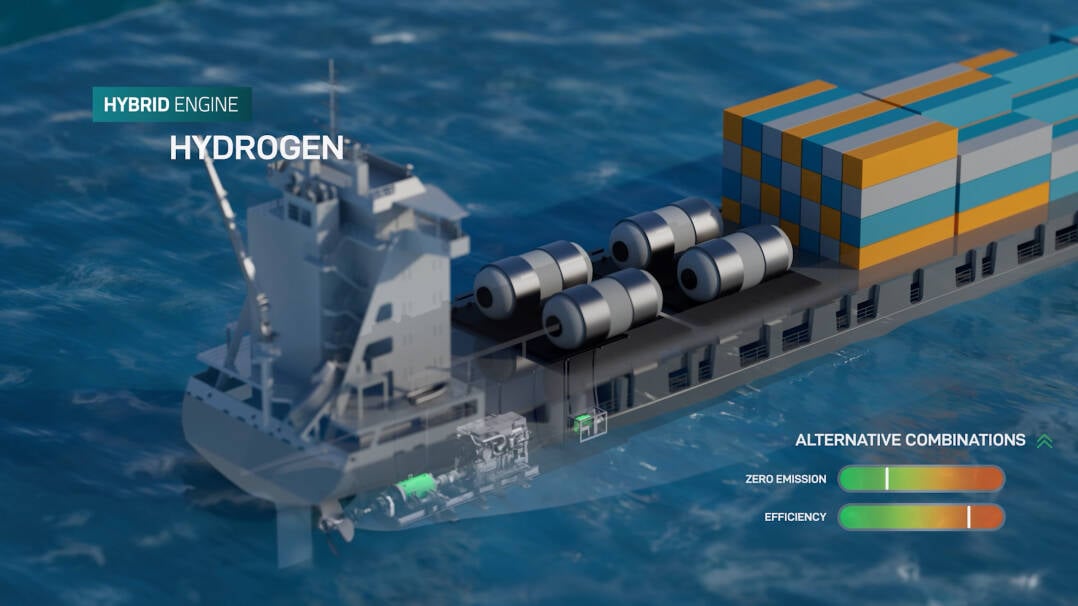
Further research
When looking to the future it is clear that the portal will still be a relevant source of information. But to remain relevant some limitations of the current portal must be overcome. One of those is that more complex energy and power systems such as methanol with reformers and onboard carbon capture cannot be represented within the database structure. Additionally, the resources are not always modelled consistently. Within the research projects MENENS (Methanol Powered Shipping) and SYNERGETICS (Synergies for Green Transformation of Inland and Coastal Shipping) these developments will be addressed, leading to a future-proof Sustainable Power Portal.
Key parameters that the portal outputs include energy density, power density, system readiness levels, greenhouse gas emissions, energy efficiencies and costs. The diagram above shows among others, pathways for biofuels (green) and synthetic fuels as well as energy carriers (blue - produced from electricity generated from solar/wind and carbon from industrial processes or direct air capture).
The emissions are shown according to a CO2 equivalent Global Warming Potential calculation on 20-years and 100-years impact (see chart below).
Moreover, each technology is set up in such a way that it always produces the same amount of power output, to ensure an ‘apples to apples’ comparison of emissions, efficiencies and costs. The portal can show information on the whole chain of systems, from Well-to-Wake, or only on the specific energy carriers. Data can be represented in different charts, the most frequently used is the greenhouse gas emissions per unit of power for each system chain.
SAPS
The working group Sustainable Alternative Power for Ships (SAPS), of which MARIN was a member, was tasked with performing a study on the greenhouse gas emissions of current and future energy and power systems, based on scientific publications (where available). The working group is part of the European Sustainable Shipping Forum (ESSF) and reports to the European Commission. Its members include energy companies, shipowners, shipyards, research institutes, port authorities, classification societies, engine suppliers and NGOs.
The emissions examined in the study had to include both direct and indirect effects, such as the often-debated land use change effects for the production of biofuels. The online portal, with the database supporting it, was presented as an alternative to a static report, which would inherently become obsolete after it was published. The fact that it was online also made it open to review: viewers are invited to give their comments on the data if they see any errors. This allows the content of the portal to be updated regularly and improved over time.
The portal is not limited to greenhouse gas emissions, also providing information about energy and power density of systems, efficiency, operational and capital costs of energy and power systems. The home page gives an overview of its structure (see image).

Global warming potential expressed in g CO2e/kWh. This gives the greenhouse gas emissions per unit of energy delivered by an energy and power system. The orange line shows the benchmark, using conventional diesel oil with an internal combustion engine. Blue lines are the energy carriers produced from solar and wind. Green lines show energy carriers produced from biomass. Note that fuels produced from biomass can exceed the emissions of conventional diesel oil. Fossil-based fuels are not included in the current figure, as most exceed emission reduction targets, but they are available online for completeness. Interactive overview is available at https://sustainablepower.application.marin.nl

The data used by the Sustainable Power Portal is often based on unvalidated system specifications. The ZEL is a high-fidelity experimental facility of MARIN concerning future energy and power systems. Test campaigns performed in the ZEL's alternative fuel systems can provide validated results on parameters such as fuel cell efficiency, which could then be used to upgrade the portal.
Recently the RVO (Netherlands Enterprise Agency) also released a roadmap of the energy transition for seagoing ships. MARIN was one of the partners in evaluating the content of the roadmap using its expertise and knowledge gained from the Sustainable Power Portal.
How does MARIN’s Zero Emission Lab (ZEL) contribute to the portal?
Well-to-Wake
The structure follows a Well-to-Wake approach where we consider the chain of systems from the ‘Well’, where the energy carrier was sourced, to the ‘Wake’ - what the ship leaves behind in its wake. The production of the energy carrier from the resources are considered Well-to-Tank and the conversion of the energy carrier into power is considered Tank-to-Wake. Combined, they make up the Well-to-Wake pathway, also called life-cycle assessment.



October 2024, no. 141
Global warming potential expressed in g CO2e/kWh. This gives the greenhouse gas emissions per unit of energy delivered by an energy and power system. The orange line shows the benchmark, using conventional diesel oil with an internal combustion engine. Blue lines are the energy carriers produced from solar and wind. Green lines show energy carriers produced from biomass. Note that fuels produced from biomass can exceed the emissions of conventional diesel oil. Fossil-based fuels are not included in the current figure, as most exceed emission reduction targets, but they are available online for completeness. Interactive overview is available at https://sustainablepower.application.marin.nl

The data used by the Sustainable Power Portal is often based on unvalidated system specifications. The ZEL is a high-fidelity experimental facility of MARIN concerning future energy and power systems. Test campaigns performed in the ZEL's alternative fuel systems can provide validated results on parameters such as fuel cell efficiency, which could then be used to upgrade the portal.
Recently the RVO (Netherlands Enterprise Agency) also released a roadmap of the energy transition for seagoing ships. MARIN was one of the partners in evaluating the content of the roadmap using its expertise and knowledge gained from the Sustainable Power Portal.
How does MARIN’s Zero Emission Lab (ZEL) contribute to the portal?
Further research
When looking to the future it is clear that the portal will still be a relevant source of information. But to remain relevant some limitations of the current portal must be overcome. One of those is that more complex energy and power systems such as methanol with reformers and onboard carbon capture cannot be represented within the database structure. Additionally, the resources are not always modelled consistently. Within the research projects MENENS (Methanol Powered Shipping) and SYNERGETICS (Synergies for Green Transformation of Inland and Coastal Shipping) these developments will be addressed, leading to a future-proof Sustainable Power Portal.
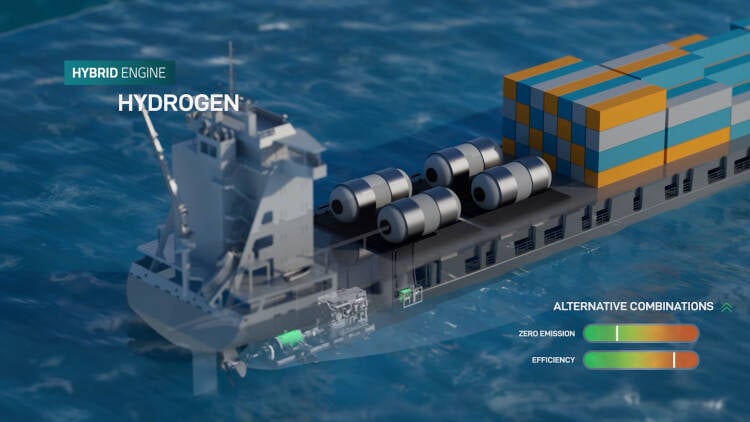
The portal visualised: from left to right the pathway of the energy from a resource to delivered power for ships.

Each technology is set up in such a way that it always produces the same amount of power output.

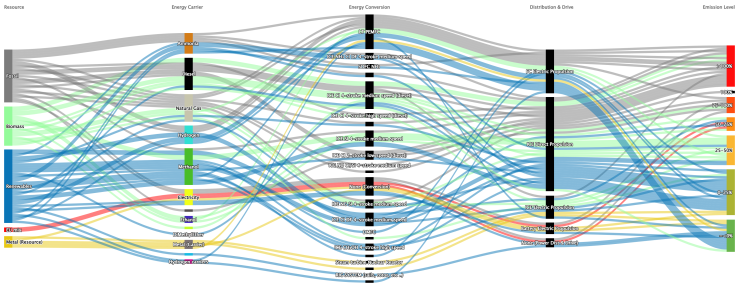
Overview of Energy-Power Systems pathways and the relative impact on emissions, as documented in the portal. Interactive overview is available at https://sustainablepower.application.marin.nl
Moreover, each technology is set up in such a way that it always produces the same amount of power output, to ensure an ‘apples to apples’ comparison of emissions, efficiencies and costs. The portal can show information on the whole chain of systems, from Well-to-Wake, or only on the specific energy carriers. Data can be represented in different charts, the most frequently used is the greenhouse gas emissions per unit of power for each system chain.
More info
Interested? Contact us to discuss your options
Key parameters that the portal outputs include energy density, power density, system readiness levels, greenhouse gas emissions, energy efficiencies and costs. The diagram above shows among others, pathways for biofuels (green) and synthetic fuels as well as energy carriers (blue - produced from electricity generated from solar/wind and carbon from industrial processes or direct air capture).
The emissions are shown according to a CO2 equivalent Global Warming Potential calculation on 20-years and 100-years impact (see chart below).
The energy and power systems that were part of the study.
SAPS
The working group Sustainable Alternative Power for Ships (SAPS), of which MARIN was a member, was tasked with performing a study on the greenhouse gas emissions of current and future energy and power systems, based on scientific publications (where available). The working group is part of the European Sustainable Shipping Forum (ESSF) and reports to the European Commission. Its members include energy companies, shipowners, shipyards, research institutes, port authorities, classification societies, engine suppliers and NGOs.
The emissions examined in the study had to include both direct and indirect effects, such as the often-debated land use change effects for the production of biofuels. The online portal, with the database supporting it, was presented as an alternative to a static report, which would inherently become obsolete after it was published. The fact that it was online also made it open to review: viewers are invited to give their comments on the data if they see any errors. This allows the content of the portal to be updated regularly and improved over time.
The portal is not limited to greenhouse gas emissions, also providing information about energy and power density of systems, efficiency, operational and capital costs of energy and power systems. The home page gives an overview of its structure (see image).
As part of MARIN’s strategy to contribute to the maritime energy transition, we invested in extending industry knowledge regarding energy carriers (hydrogen, methanol, biodiesels) and power systems (engines, fuel cells). However, it became clear pretty quickly that information about these systems is often difficult to find and compare, and the sources have varying accuracy.
Therefore, MARIN started collecting and evaluating information on this topic in 2018 via industry peers, conferences, scientific publications and suppliers, and decided to create a database so all the information was in one place, in 2020.
MARIN continues to advance its Sustainable Power Portal. Originally developed in 2020, the online portal provides an independent overview of current and future energy carriers and power systems and their associated greenhouse gas emissions.
Sustainable Power Portal
Create a MARIN account to stay updated





Report







